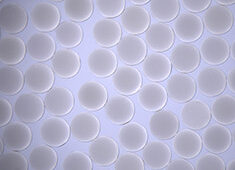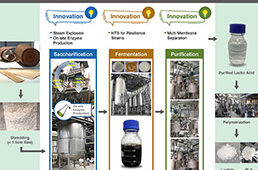Eric M. Furst reports new findings of how tiny particle building blocks can be directed to self-assemble into specific structures. Photo by Kathy F. Atkinson |
Imagine a computer chip that can assemble itself.
According
to Eric M. Furst, professor of chemical and biomolecular engineering at
the University of Delaware, engineers and scientists are closer to
making this and other scalable forms of nanotechnology a reality as a
result of new milestones in using nanoparticles as building blocks in
functional materials.
Furst
and his postdoctoral researchers, James Swan and Paula Vasquez, along
with colleagues at NASA, the European Space Agency, Zin Technologies and
Lehigh University, reported the finding Sept. 17 in an article in the Proceedings of the National Academies of Science (PNAS) online edition.
Entitled
“Multi-scale kinetics of a field-directed colloidal phase transition,”
the article details how the research team’s exploration of colloids,
microscopic particles that are mere hundredths the diameter of a human
hair, to better understand how nano-“building blocks” can be directed to
“self-assemble” into specific structures.
The
research team studied paramagnetic colloids while periodically applying
an external magnetic field at different intervals. With just the right
frequency and field strength, the team was able to watch the particles
transition from a random, solid like material into highly organized
crystalline structures or lattices.
According
to Furst, a professor in UD’s Department of Chemical and Biomolecular
Engineering, no one before has ever witnessed this guided “phase
separation” of particles.
“This
development is exciting because it provides insight into how
researchers can build organized structures, crystals of particles, using
directing fields and it may prompt new discoveries into how we can get
materials to organize themselves,” Furst said.
Because
gravity plays a role in how the particles assemble or disassemble, the
research team studied the suspensions aboard the International Space
Station (ISS) through collaborative efforts with NASA scientists and
astronauts. One interesting observation, Furst reported, was how the
structure formed by the particles slowly coarsened, then rapidly grew
and separated—similar to the way oil and water separate when
combined—before realigning into a crystalline structure.
This image shows the work by UD’s Eric M. Furst, who reports new findings of how tiny particle building blocks can be directed to self-assemble into specific structures. |
Already,
Furst’s lab has created novel nanomaterials for use in optical
communications materials and thermal barrier coatings. This new detail,
along with other recorded data about the process, will now enable
scientists to discover other paths to manipulate and create new
nanomaterials from nanoparticle building blocks.
“Now,
when we have a particle that responds to an electric field, we can use
these principles to guide that assembly into structures with useful
properties, such as in photonics,” Furst added.
The
work could potentially prove important in manufacturing, where the
ability to pre-program and direct the self-assembly of functional
materials is highly desired.
“This
is the first time we’ve presented the relationship between an initially
disordered structure and a highly organized one and at least one of the
paths between the two. We’re excited because we believe the concept of
directed self-assembly will enable a scalable form of nanotechnology,”
he said.
Multi-scale kinetics of a field-directed colloidal phase transition
Source: University of Delaware






